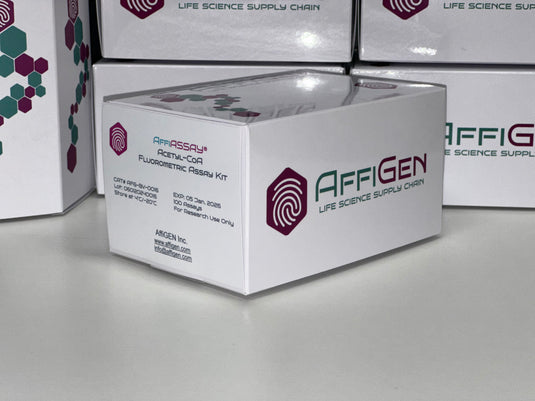


AffiASSAY® Acetyl-CoA Fluorometric Assay Kit
AffiASSAY® Acetyl-CoA Fluorometric Assay Kit is designed to provide precise and reliable measurements of Acetyl-CoA levels in a variety of biological samples, this assay kit is a powerful tool for researchers in the fields of biochemistry, cell biology, and molecular biology.
Key Features:
- High Sensitivity: Our assay kit is optimized to detect even low levels of Acetyl-CoA, allowing for accurate quantification in a wide range of samples.
- Fluorometric Detection: Utilizing a highly sensitive fluorometric assay, our kit ensures robust and reproducible results, minimizing the margin for error.
- Wide Application: The AffiASSAY® Acetyl-CoA Fluorometric Assay Kit can be used with a broad range of sample types, including cells, tissues, and purified enzyme preparations.
- Quick and Easy: With a simple and streamlined protocol, you can obtain results in just a few easy steps, saving you valuable time in the lab.
- Versatile: Whether you're studying cellular metabolism, investigating the effects of drug compounds, or exploring the intricacies of enzymatic reactions, our kit provides the versatility you need.
Assay Principle:
This assay kit employs a fluorometric method based on the enzymatic conversion of Acetyl-CoA into a fluorescent product. The increase in fluorescence intensity is directly proportional to the Acetyl-CoA concentration in your sample, allowing for precise quantification.
Applications:
- Metabolic Research: Study the role of Acetyl-CoA in cellular energy production and lipid metabolism.
- Drug Development: Assess the impact of pharmaceutical compounds on Acetyl-CoA levels, aiding in drug discovery.
- Enzyme Kinetics: Investigate the kinetics of Acetyl-CoA-utilizing enzymes with accuracy and ease.
- Cellular Signaling: Explore the connections between Acetyl-CoA and cellular signaling pathways.
Kit Contents:
- Assay Buffer
- Acetyl-CoA Standard
- Enzyme Mix
- Developer Solution
- 96-Well Assay Plate
- Detailed Protocol
Why Choose AffiASSAY®?
Our commitment to excellence and scientific rigor makes AffiASSAY® the trusted choice of researchers worldwide. We strive to provide you with innovative tools that deliver precise results and accelerate your research efforts.
AffiASSAY® Acetyl-CoA Fluorometric Assay Kit Protocol:
[Please note that this protocol is a general guideline, and you should always refer to the specific instructions provided in the kit manual for accurate and detailed information.]
Materials Needed:
- AffiASSAY® Acetyl-CoA Fluorometric Assay Kit
- Biological samples containing Acetyl-CoA
- 96-well microplate
- Microplate reader capable of measuring fluorescence (excitation: ~535-575 nm, emission: ~585-625 nm)
- Pipettes and tips
- Microcentrifuge tubes
Protocol:
Sample Preparation:
- Prepare your biological samples containing Acetyl-CoA. These samples can be cell lysates, tissue homogenates, or purified enzyme preparations.
- Ensure that your samples are stored and handled according to your specific experimental requirements.
Standard Curve Preparation:
- Reconstitute the Acetyl-CoA Standard provided in the kit according to the kit's instructions.
- Create a series of standard dilutions using the reconstituted Acetyl-CoA standard to generate a standard curve. Typical concentrations may range from 0 to 100 µM.
Assay Plate Setup:
- Label the microplate wells according to your experimental design, including wells for your samples, standards, and controls.
- If using controls, prepare a control sample without Acetyl-CoA to serve as a background control.
Sample Dilution:
- Dilute your biological samples as needed to ensure that they fall within the linear range of the standard curve. The specific dilution factor will depend on the expected Acetyl-CoA concentration in your samples.
Assay Reaction:
- Prepare the assay reaction mix by combining the Assay Buffer and Enzyme Mix from the kit as instructed.
- Add 50-100 µL of the assay reaction mix to each well of the microplate.
Sample and Standard Addition:
- Add 50-100 µL of your diluted samples and Acetyl-CoA standards to the appropriate wells on the microplate.
- Ensure that the final reaction volume in each well is consistent.
Incubation:
- Incubate the microplate at the appropriate temperature (as specified in the kit instructions) for a recommended time to allow the enzymatic conversion of Acetyl-CoA to a fluorescent product.
Fluorescence Measurement:
- Using a microplate reader with appropriate fluorescence settings, measure the fluorescence intensity of each well. Excitation should be around 535-575 nm, and emission around 585-625 nm.
Data Analysis:
- Generate a standard curve using the fluorescence values obtained from the Acetyl-CoA standards.
- Calculate the Acetyl-CoA concentrations in your samples based on their respective fluorescence readings and the standard curve.
Results Interpretation:
- Interpret and analyze your results according to your research objectives.
- Note any variations or trends in Acetyl-CoA levels among your samples.
Data Presentation:
- Prepare your data for presentation or publication, and include the appropriate statistical analysis if required.
Cleanup:
- Dispose of all waste materials, including used assay components, according to your laboratory's safety protocols.
- Always refer to the specific instructions provided with the AffiASSAY® Acetyl-CoA Fluorometric Assay Kit for any kit-specific details or variations in the protocol.
- Additionally, ensure that you adhere to the best practices and safety guidelines in your laboratory while conducting the assay.



